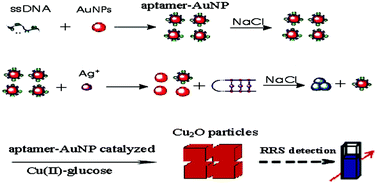A highly sensitive aptamer method for Ag+ sensing using resonance Rayleigh scattering as the detection technique and a modified nanogold probe†
Abstract
An aptamer was modified using a

* Corresponding authors
a
Key Laboratory of Ecology of Rare and Endangered Species and Environmental Conservation of Education Ministry; Guangxi Key Laboratory of Environmental Pollution Control Theory and Technology, Guangxi Normal University, Guilin 541004, China
E-mail:
ahliang2008@163.com, zljiang@mailbox.gxnu.edu.cn
Fax: +86-0773-6846201
Tel: +86-0773-5846141
An aptamer was modified using a

 Please wait while we load your content...
Something went wrong. Try again?
Please wait while we load your content...
Something went wrong. Try again?
G. Wen, C. Lin, M. Tang, G. Liu, A. Liang and Z. Jiang, RSC Adv., 2013, 3, 1941 DOI: 10.1039/C2RA22542E
To request permission to reproduce material from this article, please go to the Copyright Clearance Center request page.
If you are an author contributing to an RSC publication, you do not need to request permission provided correct acknowledgement is given.
If you are the author of this article, you do not need to request permission to reproduce figures and diagrams provided correct acknowledgement is given. If you want to reproduce the whole article in a third-party publication (excluding your thesis/dissertation for which permission is not required) please go to the Copyright Clearance Center request page.
Read more about how to correctly acknowledge RSC content.
 Fetching data from CrossRef.
Fetching data from CrossRef.
This may take some time to load.
Loading related content
